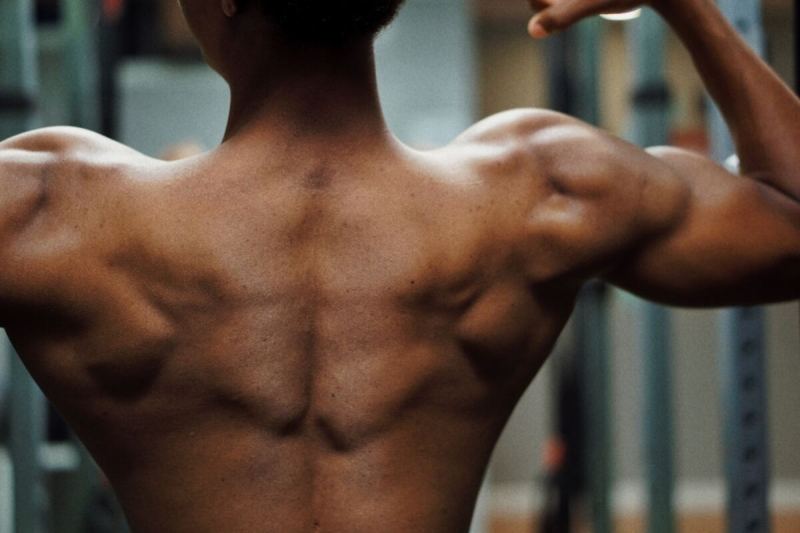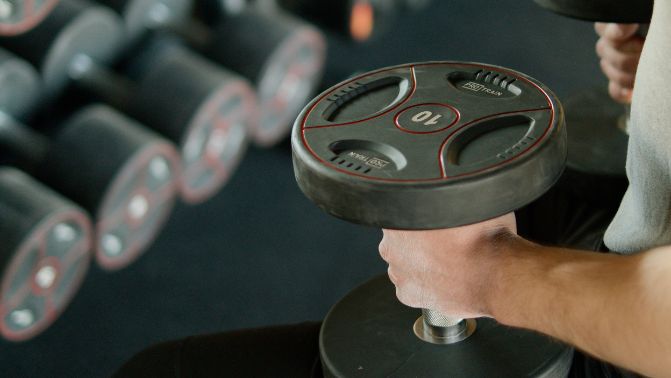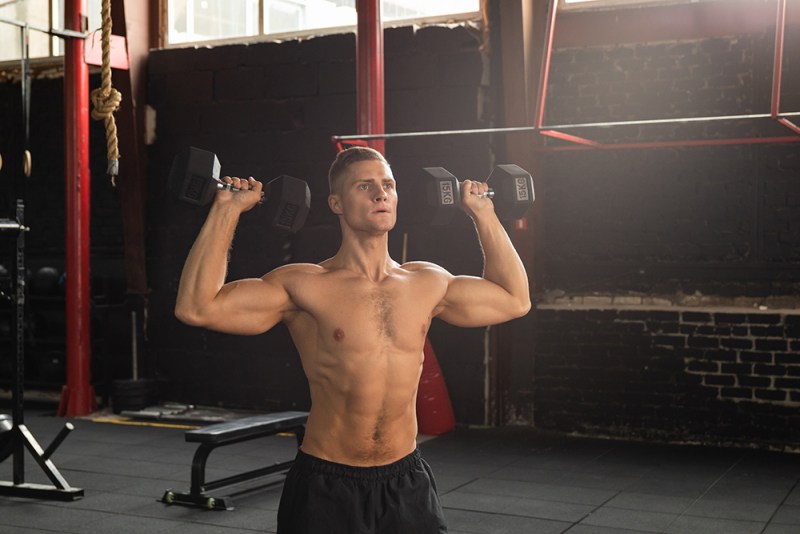
When building a fit and muscular body, developing huge shoulders is usually a part of the plan. For some, strong shoulders is the number one priority. If that sounds like you, using dumbbells during routine exercises is considered one of the best ways to realize those full and rounded shoulders you’re looking for.
In fact, the best shoulder workouts implement dumbbells into a weekly routine specifically because they add desirable shoulder mass.
When thinking about developing huge shoulders, we’re mostly talking about increasing the size of our deltoids (delts). You have three deltoid muscles, and they are the anterior, lateral, and posterior delts.
Compared to other joints in our body, such as the elbow or knee, the shoulder joint is also quite mobile. This important ball-and-socket joint allows our shoulders to move in different directions, like up, back, and sideways, so it’s easy to exercise. It also lets your arms rotate in and out.

Do you only need dumbbells for bigger shoulders?
Most professionals agree that a great tool for training your shoulders is to work out with dumbbells. Some people also prefer to use barbells or cable machines while exercising, and plenty of good routines utilize this equipment.
However, dumbbells can be safer because our shoulders are prone to injuries. Therefore, we should avoid using heavy free weights and instead stick with dumbbells. They also allow us to move our shoulders from different angles.
It’s all about the angles if you want to train your shoulders effectively. Shoulder exercises should engage all three heads of your deltoids so you build rounded, balanced shoulders.
Dumbbells work each shoulder individually, so if you have a weaker one, you can train it to become stronger. Be sure to have a variety of different weights on hand, or join a local gym that gives you access to the best dumbbells for your needs.

How heavy should dumbbells be for shoulders?
If you’ve just started resistance training with dumbbells, you may be uncertain about what will work best. First, you must find the right weight. If the weight you choose is too heavy, you risk strain or injury. If it ends up being too light, you won’t be getting the workout you need.
Consider a couple of things when choosing the right weight for your dumbbells:
- What exercises will you be doing?
- What are your fitness goals?
- What is your current level of strength?
- How experienced are you at lifting?
Answering these questions honestly and acting accordingly will help you maximize gains and avoid injuries. You might also benefit from the advice of your physician, coach, and/or physical trainer.
The weight of dumbbells ranges widely, but many people stay between 10 and 25 pounds when it comes to shoulder exercises. As you begin an exercise routine with dumbbells, play around and experiment with different weights. This will help you choose the ones that fatigue your muscles without excess straining.
The right dumbbells for beginners are typically the ones that make you feel challenged but able to complete the reps without wiping yourself out.

5 dumbbell exercises for sculpted shoulders
Front raises
Dumbbell front raises give you a solid, fundamental weight training exercise. This is especially true if you want to build strength in your shoulders or create more definition. Use a dumbbell front raise during any upper body workout, and pick a weight you can lift while maintaining proper form.
Instructions:
- Stand with your feet shoulder-width apart.
- Let your arms hang in front of you.
- Place the dumbbells in front of your thighs. Make sure your palms face your thighs.
- Straighten your back and keep your feet planted flat on the floor.
- Engage your abdominal muscles. Exhale while lifting the weights upward. Extend your arms with palms facing down. Slightly bend your elbows to limit stress on the joints.
- Pause when your arms are horizontal to the floor.
- Inhale while slowly lowering the dumbbells to your thighs with control.
Lateral raises
Lateral raises require you to lift weights out to the side and away from your body. This looks much easier than it is, so choose lighter weights to start. Lighter weights still help to build strength and size. They’ll also improve your shoulder’s range of motion and stability.
Instructions:
- Stand with your feet shoulder-width apart
- Hold a dumbbell in each hand by your sides. Make sure your palms face inward.
- Engage your core and squeeze your glutes as you raise your arms out to the sides. Softly bend your elbows to help prevent injury.
- Stop when your arms are parallel to the floor.
- Pause before slowly lowering back to the starting position.
Rear delt flyes
The dumbbell rear delt, or reverse, fly works out your posterior deltoid muscle, giving it definition and strength. Learning this exercise will greatly improve your shoulders!
Instructions:
- While holding a dumbbell in each hand, slightly hinge forward at your waist. Your palms should be facing each other.
- Contract your rear deltoids with your arms slightly bent. Bring the weight up and out to your sides, and squeeze your shoulder blades together. Maintain a straight back throughout this movement.
- Slowly lower your arms back down to the starting position.
Overhead press
You can do the overhead press while sitting or standing. You can also hold dumbbells horizontally at your shoulders or rotated in a hammer grip. This exercise benefits anyone utilizing an upper-body strength workout.
Keep in mind that this can be difficult if you don’t have experience using dumbbells for reps. Start low and go slow to avoid injury.
Instructions:
- Stand upright and straighten your back.
- Hold a dumbbell in each hand, at your shoulders, with an overhand grip. Keep your thumbs on the inside and knuckles face up.
- Exhale as you straighten your arms and raise the weights above your head with control.
- Pause briefly at the top and inhale as you return the dumbbells to your starting position.
Arnold press
If you want to build broad, muscular shoulders, consider this exercise from famous bodybuilder Arnold Schwarzenegger. His take on the dumbbell overhead press engages all three sections of your deltoids. This includes the round muscles at the tops of your upper arms building fuller, wider, more defined shoulders and improving your posture too.
Instructions:
- Hold the dumbbells in front of your shoulders at the collarbone. Keep your hands facing you.
- Rotate your hands so your palms are facing away from you and are outside your shoulders.
- Drive the weights upward and fully extend your elbows as you press the dumbbells up.
- Reach the top of the lift and reverse the movement.
- With control, return the weights to the starting position in front of your chest.

How often should you train shoulders for best results?
When determining how often you should be training your shoulders every week, consider your goals. How much training do you want to dedicate to your shoulders every session? An average or ideal week should include three to four dumbbell shoulder workouts two to three days.



